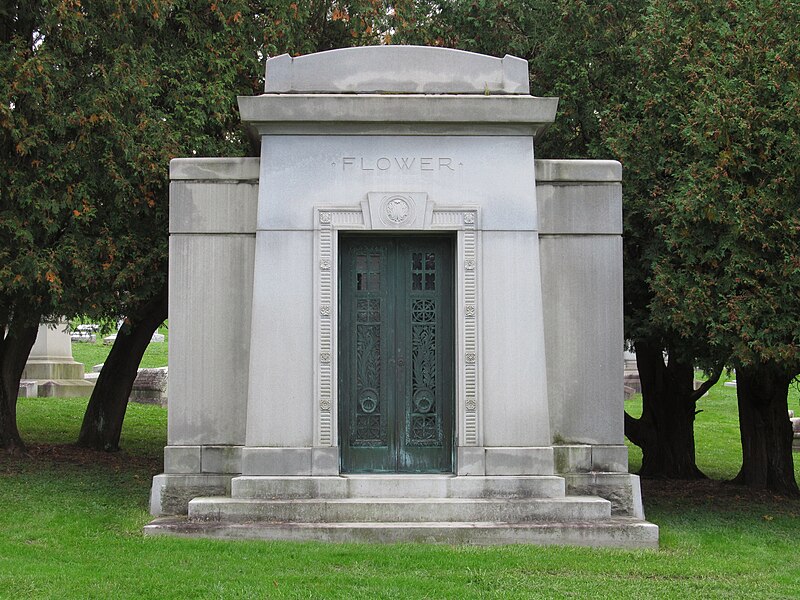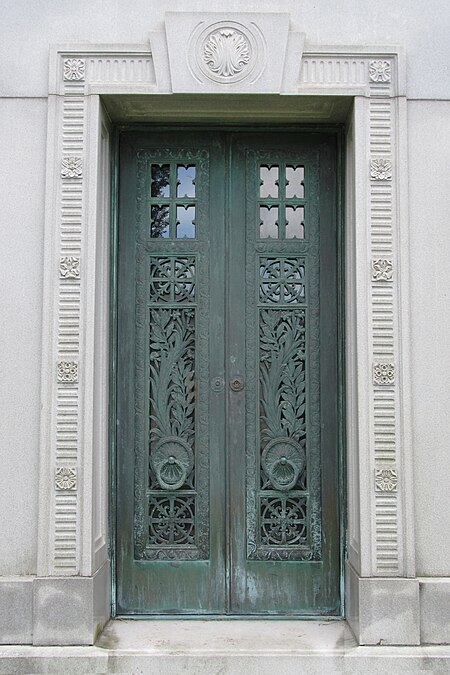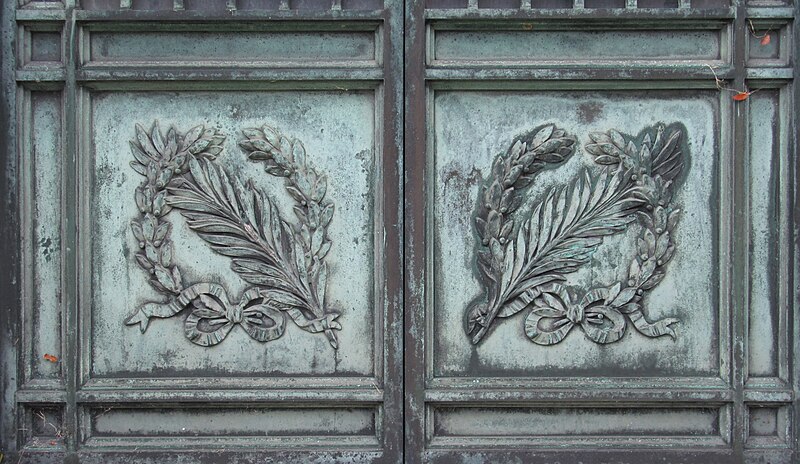
Flower-dropping mourners are very common in our cemeteries, but this one is made of bronze and unusually fine.



A tasteful mausoleum shaped like the stereotypical Egyptian temple, but without Egyptian decorative details. The nautical-themed stained glass inside is extraordinarily good, and the bronze doors are also very artistic.




Addendum: Assuming there are not two Flower mausoleums in Pittsburgh, the architect of this one was Albert G. Lowe. Source: Listing for Sullivan Granite Company in Sweet’s Catalog File, 1932, Vol. A. Under “References”: “Flower Mausoleum, Pittsburgh, Pa., Albert G. Lowe, Pittsburgh, Pa., Architect.”

Probably a stock model. It is curiously hard to pin down the style of this structure; old Pa Pitt will call it Romanesque, on account of the medievalish columns and the arched bronze doors. The stained glass inside is another standard catalogue item. The bronze doors bear reliefs of laurels and palms—symbols of victory in death.


 The composite picture above is more than 75 megapixels. Expect about 22 megabytes of data if you click on it.
The composite picture above is more than 75 megapixels. Expect about 22 megabytes of data if you click on it.
This is without a doubt the most spectacular Egyptian mausoleum in Pittsburgh. All the usual Egyptian elements are here, but the Winter mausoleum (1930)—whose colossal scale is hard to convey in a photograph—adds its own unique accessories. John Russell Pope, the famous beaux-arts architect, designed this mausoleum for banker Emil Winter—but “designed” is not really the right word here. The Woolworth mausoleum in Woodlawn, the Bronx, is nearly identical; Winter apparently saw it and told Pope “I want that,” and Pope gave it to him.
Mr. Winter’s amazing sphinxes bear an expression that old Pa Pitt can only describe as “snooty.”
 The bronze door depicts Mr. Winter himself, large as life and in full Pharaonic regalia, about to set off for his journey into the afterlife. Even this is identical to the bronze door of the Woolworth mausoleum, except for the substitution of Mr. Winter’s face.
The bronze door depicts Mr. Winter himself, large as life and in full Pharaonic regalia, about to set off for his journey into the afterlife. Even this is identical to the bronze door of the Woolworth mausoleum, except for the substitution of Mr. Winter’s face.
 Inside is a stained-glass window that reminds Father Pitt of cheap illustrated Sunday-school handouts, showing Mr. Winter properly enthroned. (It was devilishly hard to get a picture of this window, because the front doors are actually backed by a mesh screen. This was the best old Pa Pitt could do.)
Inside is a stained-glass window that reminds Father Pitt of cheap illustrated Sunday-school handouts, showing Mr. Winter properly enthroned. (It was devilishly hard to get a picture of this window, because the front doors are actually backed by a mesh screen. This was the best old Pa Pitt could do.)

A very luxurious combination of polished granite and bronze, this monument is hard for Father Pitt to date. A William McLean who died in 1873 has a headstone in this plot, but that seems too early for this style of monument. Three McLean children were buried here in the 1890s, but even that seems early. If Father Pitt had to guess from the style, he might say that the monument itself was erected in the 1920s, perhaps replacing an earlier marble monument from 1873 that had already eroded beyond recognition.